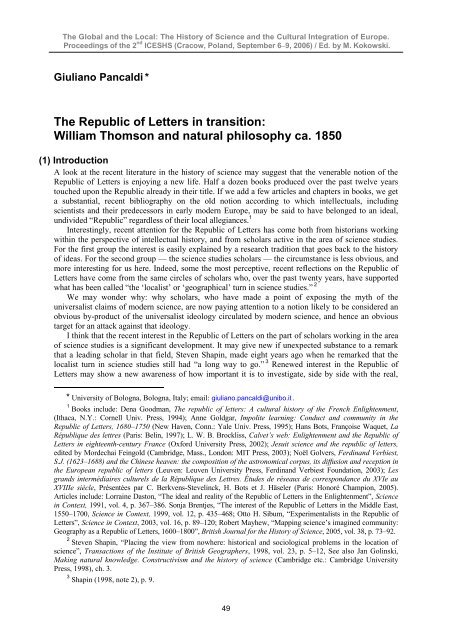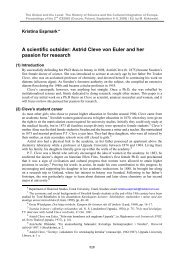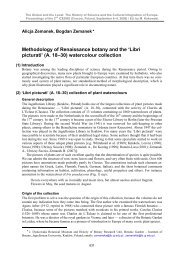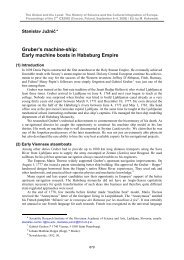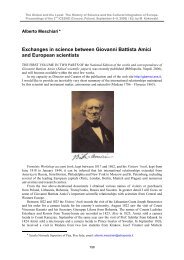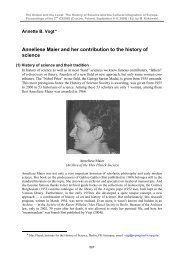Full text PDF (166 kB) - 2nd ICESHS
Full text PDF (166 kB) - 2nd ICESHS
Full text PDF (166 kB) - 2nd ICESHS
Create successful ePaper yourself
Turn your PDF publications into a flip-book with our unique Google optimized e-Paper software.
The Global and the Local: The History of Science and the Cultural Integration of Europe.<br />
Proceedings of the 2 nd <strong>ICESHS</strong> (Cracow, Poland, September 6–9, 2006) / Ed. by M. Kokowski.<br />
Giuliano Pancaldi *<br />
The Republic of Letters in transition:<br />
William Thomson and natural philosophy ca. 1850<br />
(1) Introduction<br />
A look at the recent literature in the history of science may suggest that the venerable notion of the<br />
Republic of Letters is enjoying a new life. Half a dozen books produced over the past twelve years<br />
touched upon the Republic already in their title. If we add a few articles and chapters in books, we get<br />
a substantial, recent bibliography on the old notion according to which intellectuals, including<br />
scientists and their predecessors in early modern Europe, may be said to have belonged to an ideal,<br />
undivided ―Republic‖ regardless of their local allegiances. 1<br />
Interestingly, recent attention for the Republic of Letters has come both from historians working<br />
within the perspective of intellectual history, and from scholars active in the area of science studies.<br />
For the first group the interest is easily explained by a research tradition that goes back to the history<br />
of ideas. For the second group — the science studies scholars — the circumstance is less obvious, and<br />
more interesting for us here. Indeed, some the most perceptive, recent reflections on the Republic of<br />
Letters have come from the same circles of scholars who, over the past twenty years, have supported<br />
what has been called ―the ‗localist‘ or ‗geographical‘ turn in science studies.‖ 2<br />
We may wonder why: why scholars, who have made a point of exposing the myth of the<br />
universalist claims of modern science, are now paying attention to a notion likely to be considered an<br />
obvious by-product of the universalist ideology circulated by modern science, and hence an obvious<br />
target for an attack against that ideology.<br />
I think that the recent interest in the Republic of Letters on the part of scholars working in the area<br />
of science studies is a significant development. It may give new if unexpected substance to a remark<br />
that a leading scholar in that field, Steven Shapin, made eight years ago when he remarked that the<br />
localist turn in science studies still had ―a long way to go.‖ 3 Renewed interest in the Republic of<br />
Letters may show a new awareness of how important it is to investigate, side by side with the real,<br />
* University of Bologna, Bologna, Italy; email: giuliano.pancaldi@unibo.it .<br />
1 Books include: Dena Goodman, The republic of letters: A cultural history of the French Enlightenment,<br />
(Ithaca, N.Y.: Cornell Univ. Press, 1994); Anne Goldgar, Impolite learning: Conduct and community in the<br />
Republic of Letters, 1680–1750 (New Haven, Conn.: Yale Univ. Press, 1995); Hans Bots, Françoise Waquet, La<br />
République des lettres (Paris: Belin, 1997); L. W. B. Brockliss, Calvet’s web: Enlightenment and the Republic of<br />
Letters in eighteenth-century France (Oxford University Press, 2002); Jesuit science and the republic of letters,<br />
edited by Mordechai Feingold (Cambridge, Mass., London: MIT Press, 2003); Noël Golvers, Ferdinand Verbiest,<br />
S.J. (1623–1688) and the Chinese heaven: the composition of the astronomical corpus, its diffusion and reception in<br />
the European republic of letters (Leuven: Leuven University Press, Ferdinand Verbiest Foundation, 2003); Les<br />
grands intermédiaires culturels de la République des Lettres. Études de réseaux de correspondance du XVIe au<br />
XVIIIe siècle, Présentées par C. Berkvens-Stevelinck, H. Bots et J. Häseler (Paris: Honoré Champion, 2005).<br />
Articles include: Lorraine Daston, ―The ideal and reality of the Republic of Letters in the Enlightenment‖, Science<br />
in Con<strong>text</strong>, 1991, vol. 4, p. 367–386. Sonja Brentjes, ―The interest of the Republic of Letters in the Middle East,<br />
1550–1700, Science in Con<strong>text</strong>, 1999, vol. 12, p. 435–468; Otto H. Sibum, ―Experimentalists in the Republic of<br />
Letters‖, Science in Con<strong>text</strong>, 2003, vol. 16, p. 89–120; Robert Mayhew, ―Mapping science‘s imagined community:<br />
Geography as a Republic of Letters, 1600–1800‖, British Journal for the History of Science, 2005, vol. 38, p. 73–92.<br />
2 Steven Shapin, ―Placing the view from nowhere: historical and sociological problems in the location of<br />
science‖, Transactions of the Institute of British Geographers, 1998, vol. 23, p. 5–12, See also Jan Golinski,<br />
Making natural knowledge. Constructivism and the history of science (Cambridge etc.: Cambridge University<br />
Press, 1998), ch. 3.<br />
3 Shapin (1998, note 2), p. 9.<br />
49
CHAPTER 2. / Plenary Lectures<br />
<strong>2nd</strong> International Conference of the ESHS<br />
local communities in which scientists are rooted, also those other communities that a geographer,<br />
Robert Mayhew, has called recently imagined communities. 4<br />
Imagined communities in the sciences can be identified, for example, by studying the citation<br />
patterns prevailing in a certain discipline: citations that typically involve colleagues both from within<br />
and across national borders. Citation patterns of course have limitations as a tool, but the notion of<br />
imagined communities and the plea implicit in focusing on them now that the localist turn has gone<br />
some way are I think worthy of attention.<br />
As I see it, once we have got rid of the mythological aspect of the Republic of Letters notion, what<br />
remains to be understood is precisely the role played by imagined communities in the dynamics of<br />
science. Only by considering these communities will we have a chance to understand how local and<br />
distant factors combine in the production of knowledge. 5<br />
What I propose to do in my talk is an exercise in this kind of investigation. The period I will be<br />
talking about is the early Victorian period. The field is ―natural philosophy‖ at a time when it was<br />
shifting into the discipline we now call physics. The scientist I will take as an exemplar is William<br />
Thomson, later Lord Kelvin. I will explore how the imagined, international communities of natural<br />
philosophers and experimenters Thomson claimed to belong to combined with powerful local factors<br />
in shaping his early career, as well as the physics laboratory that he developed at the University of<br />
Glasgow in the late 1840s.<br />
(2) Politics<br />
To begin with, let me say a few words about the historical period I will be talking about, the early<br />
Victorian age, and about politics. The notion of a Republic of Letters properly belongs to a time and<br />
circumstances that precede the time and circumstances I will be considering. Among historians it is<br />
agreed that the notion of an ideal Republic of intellectuals belongs to early-modern Europe and to the<br />
eighteenth-century. According to current periodizations, after the Napoleonic wars the old cosmopolitan<br />
ideal had to face the growing challenges posed by ever more powerful nation-states. In order to<br />
survive, we are told, the cosmopolitan ideal had to turn into one form or another of what was called,<br />
later in the nineteenth century, internationalism.<br />
However, it should also be noted that, within the British liberal circles I will be considering, the<br />
period from the end of the Napoleonic wars to mid-century was depicted as especially conducive to<br />
international undertakings. Around mid-century, that period became known in England as ―the thirty<br />
years peace‖. A book bearing that title was published in London in 1849 by Harriet Martineau, the<br />
writer who circulated the ideas of Malthus, Ricardo and John Stuart Mill among the British public. 6 As<br />
is well-known, Martineau conveyed views often subscribed to in political circles that saw science as<br />
an important new factor in society, and in international relations as well. Indeed, in Britain the period<br />
from 1815 to the end of the 1840s saw a number of initiatives bearing traces of the old cosmopolitan<br />
ideal. The 1840s, for example, saw the posthumous publication of Jeremy Bentham‘s Principles of<br />
international law, in which Bentham advocated the elimination of wars basically for the benefits<br />
deriving to commerce. 7 Martineau also circulated the works of French philosopher Auguste Comte in<br />
Britain. Comte supported what he called ―the co-operation of the best minds in each nation‖.<br />
According to Comte, recently established societies like the associations for the advancement of<br />
4 Robert Mayhew (2005, note 1). The notion of ―imagined communities‖ was used by Benedict Anderson to<br />
explore the origin and spread of nationalism; see: Benedict Anderson, Imagined communities. Reflections on the<br />
origin and spread of nationalism (London and New York: Verso, 2006; first edition 1983). Anderson‘s treatment<br />
is an appropriate antidote to the historians‘ of science temptation to idealize science‘s imagined communities. I<br />
am grateful to Joan Cadden for having led me to Anderson‘s book, pointing out its possible relevance for the<br />
argument developed here.<br />
5 For some perceptive reflections on ‖knowledge as constituted through a range of distance-based partial<br />
perceptions‖, see Mario Biagioli, Galileo’s instruments of credit. Telescopes, images, secrecy (Chicago etc.:<br />
The University of Chicago Press, 2006), pp. 23–26.<br />
6 Harriet Martineau, The history of England during the thirty years’ peace: 1816–1846 (London: Knight, 1849).<br />
7 In: Jeremy Bentham, Works, John Bowring (ed.) (1843), vol. 2, p. 535–560.<br />
50
Guliano Pancaldi<br />
The Republic of Letters in transition: William Thomson and natural philosophy ca. 1850<br />
science expressed, in different countries, ―the true cosmopolitan character of modern science‖. 8<br />
Comte‘s views were further circulated in Britain by John Stuart Mill. 9 They were received favorably<br />
also by scientists like David Brewster, who in 1845 was among those willing to support young<br />
William Thomson‘s European ambitions. 10<br />
I am mentioning all this to emphasize that, in the 1840s, the upper-middle-class intellectual elites<br />
to which Thomson belonged could perceive the relatively ―pacific‖ age in which they lived as especially<br />
conducive to international cooperation. This perception could easily merge with the cosmopolitan<br />
rhetoric that, since the eighteenth century and before, had depicted the natural sciences as a crossnational<br />
undertaking.<br />
But let me turn to Thomson himself to see how, concretely, the cosmopolitan rhetoric was made to<br />
fit into the reality of local needs and circumstances, and how international communication contributed<br />
to shaping the many faces of William Thomson.<br />
(3) The many faces of William Thomson<br />
Yes, because in the history of science Thomson is a sort of Hydra, the many-headed monster.<br />
According to Jed Buchwald, Thomson was ―the quintessential (and perhaps first) engineering scientist‖. 11<br />
To describe Thomson‘s endeavors, one of his major biographers — Crosbie Smith — has spoken of<br />
―Thomson‘s scientific capitalism‖. 12 A historical sociologist (Terry Shinn) has described Thomson as<br />
―the scientist / engineer / technician‖. 13 Olivier Darrigol has called attention to the ―cross-cultural<br />
purpose‖ pursued by Thompson with his concepts and apparatus meant for ―physicists of various<br />
schools, chemists, mathematicians, or engineers‖. 14 To make things more intriguing, according to one<br />
of his contemporaries Thomson was above all ―the high priest of electricity‖, celebrating for popular<br />
audiences the achievements of the science and early industry of electricity. 15<br />
For sure, young Thomson had been trained to become a ―master of theory‖, to use Andrew Warwick‘s<br />
phrase. 16 Thomson had attended Cambridge at a time when that university was shaping what we now<br />
call mathematical physics, and already as a Cambridge student he had achieved important results in what<br />
he preferred to call ―physical mathematics.‖<br />
Yet, Thomson‘s background in Glasgow had provided him with a taste for broader interests and a<br />
range of different concerns. It was certainly no coincidence if, eight years after his appointment as<br />
professor of natural philosophy in industrial Glasgow, he ventured into the first of a series of telegraph<br />
patents. In another three years he was one of the chief technicians on board the ships laying the first<br />
Atlantic cables, and a director of the Atlantic Cable Company.<br />
So who really was William Thomson? The Cambridge-trained, mathematical physicist cherished<br />
by twentieth-century historians of physics? Or the keen engineer-electrician laying transatlantic cables<br />
celebrated in Victorian popular magazines? Or the proud inventor of instruments and machines, the<br />
businessman who helped the telegraph industry and the British Empire to achieve some of their most<br />
8<br />
Auguste Comte, The positive philosophy, freely translated and condensed by Harriet Martineau (sine loco:<br />
Chapman, 1853).<br />
9<br />
John Stuart Mill, Auguste Comte and positivism (sine loco: Trubner, 1865).<br />
10<br />
Silvanus P. Thompson, The life of William Thomson (London: Macmillan, 1910), p.115.<br />
11<br />
Jed Z. Buchwald, ―Energy and empire‖, essay review of Crosbie Smith and M. Norton Wise, Energy and<br />
empire: A biographical study of Lord Kelvin (1989), British Journal for the History of Science, 1991, vol. 24,<br />
p. 85–94, here p. 88, emphasis added.<br />
12<br />
Crosbie Smith, ―Nowhere but in a great town: William Thomson‘s spiral of classroom credibility‖, in:<br />
Making space for science. Territorial themes in the shaping of knowledge, ed. by Crosbie Smith and Jon Agar<br />
(London: Macmillan, 1998), p. 118–146, here p. 142.<br />
13<br />
Terry Shinn, ―Change or mutation? Reflections on the foundations of contemporary science‖, Social science<br />
information, 1999, vol. 38, p. 149–176, here p. 155.<br />
14<br />
Olivier Darrigol, Electrodynamics from Ampère to Einstein (Oxford etc.: Oxford University Press, 2000), p. 77.<br />
15 As reported in: M. A., University Pamphlets. II. Personal Experiences (Glasgow: Robert L. Holmes, 1882), p. 73.<br />
16 Andrew Warwick, Masters of theory. Cambridge and the rise of mathematical physics (Chicago etc.: The<br />
University of Chicago Press, 2003).<br />
51
CHAPTER 2. / Plenary Lectures<br />
<strong>2nd</strong> International Conference of the ESHS<br />
ambitious goals, while earning him a knighthood, and enough money to buy a grandiose house and a<br />
yacht worthy of a royal prince?<br />
Each one of these descriptions tells us something about Thomson; yet the historians‘ tentative<br />
descriptions reveal that the combination of different professional and social types in the same person<br />
may raise problems for our understanding. In what follows, by dealing with some of Thomson‘s<br />
international endeavors, I will be addressing also the question of how he managed to combine different<br />
professional types into the same person.<br />
Perhaps imagined, international communities, and the ability of individuals to play with several<br />
communities at a time — imagined, and real — is what is at stake when we get into trouble in our<br />
attempts to force historical characters into clear-cut ideal types.<br />
(4) Local opportunities<br />
But first let me say a little more about the local opportunities supporting Thomson‘s career, and how<br />
they led to international intercourse.<br />
It is well known that Thomson‘s career began within the con<strong>text</strong> provided by the old tradition of<br />
natural philosophy teaching at the University of Glasgow.<br />
It is part of that well-known story that Thomson‘s father, himself professor in Glasgow and a notable<br />
Whig, had begun maneuvering for his son to succeed to the chair of the aging professor of natural<br />
philosophy when William was barely 18. But we are not interested in the history of nepotism here.<br />
Within that well-known story, historians have assumed that Thomson‘s achievements as an excellent<br />
young mathematician and a Second Wrangler in Cambridge, together with the acquaintance he had<br />
with French mathematics, were obvious assets in the campaign for the chair.<br />
The truth was quite the reverse. The letters exchanged by father and son on what was expected of a<br />
professor of natural philosophy in Glasgow show that Thomson had to fight hard to convince both<br />
allies and adversaries that he was not ―a mere mathematician‖.<br />
A survey that William‘s father carried out of the expectations of the professors and of potential<br />
rivals in the contest, revealed that the two most valued assets for a winning candidate were, first, a<br />
demonstrated ability in ―performing experiments‖, and, second, a ‖European reputation.‖ After that<br />
survey, ―to get some practical experimental knowledge as soon as possible‖, and an exposure to the<br />
cosmopolitan side of natural philosophy, became agreed priorities for Thomson. 17<br />
But how could the young, Cambridge-trained mathematician obtain an acquaintance with ―the<br />
manipulations of experimental philosophy‖, and a European fame quickly?<br />
The answer, quite obvious in a family like the Thomsons touring the continent every summer, was<br />
travel. Within days of passing his finals in Cambridge, Thomson was in Paris determined to obtain<br />
there what he still lacked after six years as a student in Glasgow and three years in Cambridge. We<br />
might call Thomson‘s strategy on the occasion: exotic answers to local challenges.<br />
(5) Exotic answers to local challenges<br />
Aware that in Glasgow his fame was that of a mathematician ―too deep to have popular talent‖, 18<br />
Thomson used Paris as a remedy.<br />
During the four and a half months that he spent there in 1845 he exploited Paris as a shopping mall<br />
offering exposure to — and testimonials of accomplishment in — all sorts of experimental natural<br />
philosophy, serious and popular.<br />
He attended, in order of decreasing popular appeal, the lectures of Pouillet, Dumas, and Pelouze;<br />
and finally he was admitted as an assistant of sorts to the laboratory of the youngest and least popular<br />
of all: Victor Regnault, recommended by old Biot as the best physicist in Paris.<br />
As seen through the eyes of young Thomson, lecturers in Paris distinguished themselves by the<br />
abundant experimental apparatus they used, which was — he noted — ―exceedingly good and on a very<br />
extensive scale‖. Another, connected feature was that ―all the things‖ were ―prepared with great care<br />
beforehand‖, so that — Thomson noted — public experimental performances seldom failed. 19<br />
17 Silvanus P. Thompson (1910, note 10), p. 56, 54.<br />
18 Ibidem, p. 116.<br />
19 Ibidem, p. 117.<br />
52
Guliano Pancaldi<br />
The Republic of Letters in transition: William Thomson and natural philosophy ca. 1850<br />
To write down lists of the instruments that Regnault and others used in their ―cabinets de<br />
physique‖ was Thomson‘s next step. It was urged on William by his father, well aware that a major<br />
commitment of the future professor of natural philosophy in Glasgow would be to renew the old<br />
demonstration apparatus preserved there and, with new spectacular demonstrations, to help draw<br />
larger crowds of paying students to the class. 20 In the Scottish university tradition, students paid fees<br />
directly to the professors, thus contributing to about half of the professors‘ income: a challenge for<br />
which young Thomson‘s mathematical talent was of little help.<br />
So, prompted by personal career motives and by Glasgow‘s opportunities and challenges, in Paris<br />
young Thomson launched himself on a conscious process of imitation of the French. The process was<br />
to link Glasgow and Paris in the field of natural philosophy for years to come.<br />
(6) Imitation<br />
The most tangible side of the imitation process linking Glasgow and Paris was the stream of<br />
experimental apparatus that reached Thomson‘s laboratory from Paris over the years. The Paris<br />
instrument-makers involved in the imitation game included Marloye, Froment, Silbermann, Frastré,<br />
Pixii, Duboscq, and Ruhmkorff. 21<br />
The ties with enterprising French instrument makers were reinforced during subsequent visits that<br />
Thomson paid to Paris. For example in the summer of 1847, when he spent two full days in Marloye‘s<br />
workshop; or again in the fall of 1850, when he saw some beautiful experiments, conceived by<br />
Foucault, performed in Duboscq‘s workshop.<br />
One of the latter experiments is worth recalling in Thomson‘s own words. The words convey his<br />
enthusiasm — placed somewhere at the intersection between machines, manipulative expertise, and<br />
physics teaching — that helps understand the different ―faces‖ he later developed that still cause<br />
problems when assessing Thomson‘s place in the history of science and technology today. Let us read<br />
a few lines from Thomson‘s notes in Paris:<br />
A prism and lenses were arranged to throw upon a screen an approximately pure<br />
spectrum of a vertical electric arc between charcoal poles of a powerful battery, the lower<br />
one of which was hollowed like a cup.<br />
When pieces of copper and pieces of zinc were separately thrown into the cup, the<br />
spectrum exhibited, in perfectly defined positions, magnificent well-marked bands of<br />
different colours characteristic of two metals. 22<br />
Those familiar with Thomson‘s later demonstrations with mirror electrometers and galvanometers<br />
will see the similarities between the demonstration set-up described here in Paris and the one adopted<br />
by Thomson later; for example during the Friday evening lecture at the Royal Institution in 1860,<br />
when he projected on a big screen the readings of atmospheric electricity captured with his instruments<br />
by assistants walking among the public in the crowded lecture hall. 23<br />
Let me insist: The demonstration recorded in Thomson‘s notes went on in the workshop of an<br />
instrument maker in Paris. Mr. Duboscq-Soleil was performing, assisted by the Abbé Moigno. The<br />
demonstration had been devised by Foucault, himself an interesting blend of a philosopher and an<br />
experimenter, and the Cambridge-trained young professor of natural philosophy from Glasgow was<br />
taking notes. No surprise that in the following years the ordering, shipping and setting up of French<br />
instruments occupy such a prominent place in the records of Thomson‘s laboratory in Glasgow.<br />
Around 1850, of course, the lessons to be learnt in Paris on how best to conduct the business of<br />
natural philosophy were far from unique to that place. Once the chair in Glasgow had been secured —<br />
20 Ibidem, p. 127.<br />
21 As from William Thomson‘s laboratory vouchers, National Archives of Scotland.<br />
22 William Thomson, Popular lectures and addresses, London: Macmillan, 1889, vol. II, p. 132–205, here<br />
p. 173. Thomson must have relied on his notes written in Paris when, in 1871, in the con<strong>text</strong> of the presidential<br />
address delivered to the British Association in Edinburgh, later published in his Popular lectures, he described<br />
his 1850 visit to Dubosq‘s in such detail .<br />
23 William Thomson, Reprint of papers in electrostatics and magnetism (second edition, London:<br />
Macmillan, 1884), p. 208–225, esp. p. 221–3.<br />
53
CHAPTER 2. / Plenary Lectures<br />
<strong>2nd</strong> International Conference of the ESHS<br />
a feat in which Thomson‘s French contacts played a role 24 — he expanded the scope of the imitation<br />
game further. In a few years, thanks to frequent travels, the range of models Thomson was inspired by<br />
included people and laboratories in the German states, Switzerland, and Scandinavia, as well as<br />
France. Thomson‘s laboratory practice in Glasgow was affected accordingly.<br />
The imitation game I am talking about could, of course, take place also at a local or regional level,<br />
and — interestingly — it could occasionally involve crossing disciplinary as well as national borders.<br />
A visit to the natural philosophy class of Edinburgh University for example convinced Thomson<br />
that his class, too, must have a system for darkening the room quickly, to add drama to the spectacle of<br />
optical demonstrations. When it came to the ―professor‘s platform table‖ — as Thomson called it —<br />
the models offered by lecture halls intended for medical teaching were considered. As to the best<br />
features of a ―plan of benching‖ appropriate to the natural philosophy class, the solution adopted by<br />
astronomers appeared to Thomson the most desirable, and that was ―a massive stone pier, independent<br />
of the flooring‖ to avoid unwanted oscillations during delicate optical or electrical demonstrations. 25<br />
(7) Imagined communities<br />
I have focused on the demonstration and teaching apparatus to show how concrete the effects of<br />
international exchange could be.<br />
It should also be stressed, however, how loose the community of people involved in the imitation<br />
process was. No substantial correspondence developed between Thomson and his colleagues or the<br />
instrument makers in Paris as a result of those exchanges: the imitation game between Glasgow and<br />
Paris I am talking about did not eliminate distance. The presupposed ―community‖ was, and remained,<br />
imagined rather than real.<br />
Similar considerations apply, I think, to another ―imagined community‖ in which Thomson was<br />
involved; a community that has attracted much attention from historians of physics. This was the<br />
transnational community of scholars involved in the theoretical development of electrodynamics. As<br />
Olivier Darrigol has shown, Thomson was a very good navigator as a member of that community too.<br />
As is well known, the community of the experts in electrodynamics included different, occasionally<br />
opposed traditions, such as British vs. Continental, Weberian vs. Neumanian, Thomsonian vs. Maxwellian.<br />
In that con<strong>text</strong> Thomson excelled above all as a mediator, able to get the best out of what he met with,<br />
without on the other hand developing closely-knit networks of allies, or foes for that matter. 26<br />
One might say that the loose, imagined communities I am talking about have a major strength on<br />
their side: their divisions can be crossed relatively easily, and trespassing is tolerated comparatively<br />
well, better than in the stronger, local communities we are familiar with.<br />
(8) Patents<br />
Considerations about the role of loose, imagined communities — and comparatively easy trespassing —<br />
can help our understanding of another, momentous turn in Thomson‘s career. The one associated with<br />
the decision, which Thomson and two of his colleagues in Glasgow agreed upon in 1854, to take up a<br />
patent in the field of telegraphy.<br />
Historians of science have rightly emphasized that the semi-aristocratic tradition of the Republic<br />
of Letters made it unlikely for a university professor of natural philosophy like Thomson to take out a<br />
patent. And indeed what we know about Thomson‘s first patent confirms that the initiative was of his<br />
colleague William John Macquorn Rankine, an industrial consultant as well as a professor of engineering,<br />
and a much appreciated physicist. 27<br />
24<br />
Regnault and Liouville were among the persons who furnished Thomson with testimonials on the<br />
occasion of his application for the Glasgow chair: Silvanus P. Thompson (1910, note 10), p. 177, 179–180.<br />
25<br />
As documented in manuscripts preserved among the Kelvin Papers, Glasgow University Library, Special<br />
Collections.<br />
26<br />
Darrigol (2000, note 14), p. 77, 136.<br />
27<br />
See Kelvin to Stokes, 1 December 1854, in: The correspondence between Sir George Gabriel Stokes and<br />
Sir William Thomson, ed. by David B. Wilson (Cambridge etc.: Cambridge University Press, 1990), 2 vols., p. 182.<br />
54
Guliano Pancaldi<br />
The Republic of Letters in transition: William Thomson and natural philosophy ca. 1850<br />
However, the daily life of the laboratory that Thomson set up after 1846 pursuing his penchant for<br />
the ―loose‖, international communities I am talking about show that the instruments, know-how and<br />
manpower available to him around 1850 could be turned quite easily into research facilities for the<br />
kind of industrial investigations — materials testing and instrument-development — required for<br />
telegraph patents.<br />
Thomson‘s decision in 1854 to join the contemporary telegraph craze was no doubt rooted in<br />
circumstances, people, and interests linked to Glasgow: Crosbie Smith was right when he stressed this<br />
basic point in a fascinating chapter a few years ago. 28 And yet, it is just as appropriate to say that the<br />
expertise and the laboratory facilities that Thomson threw into his patent venture in telegraphy from<br />
1854 onward had been molded by the experience he had already acquired through the imitation game<br />
on a European scale — involving experimenters and instrument makers, as well as natural philosophers —<br />
that I have discussed here.<br />
(9) Conclusion<br />
I would like to conclude with a few reflections on the uses of the Republic of Letters that we have seen<br />
at work in William Thomson‘s endeavors around 1850.<br />
For that purpose, I would like to evoke a metaphor that Thomas Nagel introduced some years ago<br />
into philosophical debate; a metaphor appropriate to the general theme of our conference, and one<br />
often quoted — in a polemical vein — within the literature supporting the ―localist turn‖ in science<br />
studies. It is the metaphor of ―the view from nowhere‖. 29<br />
Nagel used the metaphor in an attempt to capture the rationale of our efforts aimed to reach a<br />
degree of objectivity in our knowledge. Nagel‘s claims concerning our attempts to attain a ―view from<br />
nowhere‖ were quite modest. He made the point that a view or form of thought is more objective than<br />
another if it relies less on the specifics of the individual‘s makeup, and on his or her position in the<br />
world. Nagel‘s point was that there is no absolutely objective view of things, but it may be worthy<br />
trying to reach ―the view from nowhere‖.<br />
I think we may say that the loose, imagined communities that scientists like Thomson conceived<br />
and temporarily joined in their endeavors across the Republic of Letters amounted to just as many<br />
attempts to reach ―the view from nowhere‖ in the search for objectivity.<br />
After the localist turn we know that, of course, no such view can possibly be attained. And yet, as<br />
we have seen, even pragmatic, locally oriented, engineering, ―capitalist‖ scientists like Thomson<br />
occasionally indulged in that impossible exercise.<br />
I suggest that we too, the historians of science, should from time to time be allowed to indulge in<br />
the search of the view from nowhere, if we really want to understand how local and distant factors<br />
combine in scientific practice. Happily, as I see it at least, this is precisely the exercise that we are<br />
making here in Cracow thanks to the European Society for the History of Science.<br />
I wonder, however, how you will react to my suggestion that we might be here chasing after the<br />
dream of an impossible view from nowhere. Or how you will react to another suggestion I would like<br />
to make before stopping: that our European Society for the History of Science might be yet another<br />
imagined community, serving the same intriguing functions that we have seen at work discussing<br />
William Thomson and the Republic of Letters in transition.<br />
28 Crosbie Smith (1998, note 12).<br />
29 Thomas Nagel, The view from nowhere (Oxford etc.: Oxford University Press, 1989).<br />
55


